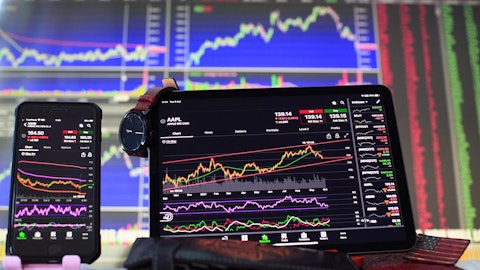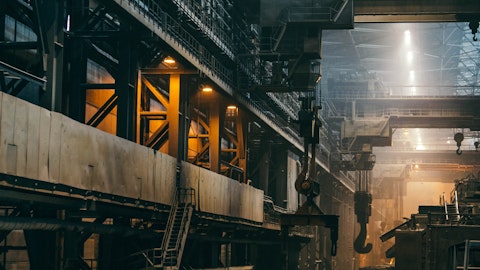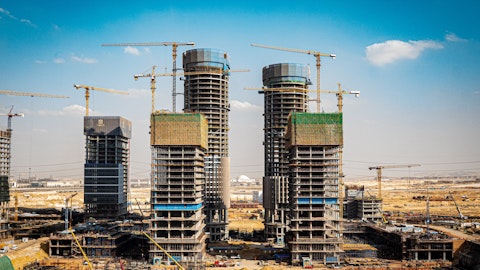Lawson Winder: Thank you, Dan. Thank you, Leon. Fantastic color. Maybe just one follow-up for me. If you could comment perhaps on the ramp-ups at Gallatin Brandenburg through 2023, including your thoughts on profitability.
Leon Topalian: Yes, absolutely. As we touched on in my opening comments on Brandenburg, we are incredibly proud of the team. The work that they have done, what they have been able to accomplish. And again, I have been at Nucor, a long time now in 26-years and from a construction standpoint, from a safety standpoint, from a budget standpoint, this project exemplifies the very best of what our team has done and produced. Al Behr will share a few more highlights of that because we have got some recent milestones that the team has reached here in just a moment. And turning to Gallatin, again, we are about six-months behind where we wanted to be on their ramp-up. However, over the last few months, that team has done a phenomenal job of bringing that new cash and equipment online.
As I mentioned during the last call, this really wasn’t just a brownfield. It was a complete mill modernization with software and automation tying that entire complex together. So it was a significant undertaking. And all that being said, the bottom line in Gallatin, in Q2, we expect them to be at full run rate capability. We will see how the market needs and demands go and meet that demand. But the other piece and point that I would share is we expect Gallatin to be profitable in the second quarter as well. So Al, maybe you want to touch on a few other things at Brandenburg.
Allen Behr: Yes, I would be happy to, Leon. Thanks, Lawson. We love talking about Brandenburg. Obviously, we are really excited about it. We are sitting here today exactly where we wanted to be. And like Leon said, I just congratulate not only the Brandenburg teammates that have just crushed it in building this project and bringing it in on time and on budget but also our Greater Plate Group teammates at Hertford at Longview at Tuscaloosa that have created an environment in which this mill is going to be excited. And as Leon alluded to, just yesterday, I’m happy to report that we made our first customer shipment out of Brandenburg. So we are on the board, and we are ready to go. In terms of the ramp-up and how we are thinking about 2023, I will share with you that we have got really three focus areas, Lawson, that we are going to think about.
Number one is the teammates that we just talked about that they are the difference makers. They are a competitive advantage. You have seen what they have done on this job site and in the market and what they have created. We are going to continue to focus on them. but also that those are the men and women that take care of our customers, which is the second area of focus. So with our customers, we have got existing customers that have helped us get to this point with our plate business. But also new customers in new markets that are new areas for us to go and serve that we couldn’t touch before. That if you remember back in 2019, the strategy around Brandenburg was to build the most broadly capable mill in the Western Hemisphere and put it in the biggest plate market in the U.S. That is what we have got.
We have built the capability set and we intend to go use it. So with those two focuses, then at least the third one, which is driving incremental returns for the enterprise. We have had the support from teammates, customers and our shareholders to put this project on the ground and now we just going to be more excited to start driving returns with it, and we are excited about what 2023 will bring.
Lawson Winder: Excellent. Thanks very much.
Operator: And our next question will come from Phil Gibbs with KeyBanc Capital Markets. Please go ahead.
Philip Gibbs: How do you guys see the global pig iron trade unfolding this year given the 25% reduction in 2022? Do you see supply chains having re-oriented at this point? Is there a reduced dependency on it given some of the new projects that have been announced by the blast furnace folks or others? Just what is the reconstruction in that market right now?
Leon Topalian: Yes. I will kick it off, Phil, and then ask Noah Hanners over raw materials to comment on that. But I just want to point out because Noah was in the Vice President role over DJJ at the time. And again, as we have mentioned a few times on this call, the day that the Russians invaded Ukraine was the last day, we took a – any material from them. And so it required Nucor to pivot incredibly quickly. Noah and the entire DJJ team stepped up. Our teams across Nucor stepped up because of the long tenured relationships that we have around the globe, because of the relationships that DJJ has built with partners and customers in South America, we were able to pivot, move very, very quickly and bringing new supply into Nucor.
At the same time, our teams have also technically figured out how to reduce our use and move from roughly what was about 10% of our pig iron use across the sheet group down to 5% or 6%. So the overall tragedy that is still continuing to unfold in Ukraine, has created a silver lining for Nucor and how we think about raw materials, our positioning strategy and our overall use and consumption. But maybe Noah just paint a picture as we think about 2023 and how that is going to shape out.
Noah Hanners: First of all, thanks for the question, Phil, and really for the opportunity to talk about our team and the performance through 2022 because I think it was really formative for how we think about employing raw materials going forward. So the short answer, I think, to your question about the balance of global pig iron supply is the Ukrainian – the invasion of Ukraine was really impactful. It was roughly 50% of the supply that went off-line when Russia invaded. But more important to us, the strength of our raw material models and the flexibility we have. If you think about how we operate about one-third of our raw materials are self-sourced between the DRI plants and our recycling group assets. So you combine this with what is really unmatched coverage of the market through our DJJ brokerage team and the flexibility of our mills in terms of what they can melt to make our products for our customers, and we can be extremely agile.
So we are able to, as Leon described, quickly change our melt mixes, maintain our focus on value and use while minimizing our cost and making the products our customers need. So again, if you look back to 2022, it is a testament to this flexibility. We prepared for the invasion to the best of our ability, we had indications that was coming. We were able to quickly pivot, adjust our melt mixes at the mills, minimize our pig iron and immediately cease purchasing from Russia. So I’m extremely proud of our team for the 2022 performance. They executed and I’m also confident in our flexibility and the strength that provides us going forward.
Philip Gibbs: Thank you. And then in fabrication, you kind of gave us a range basically somewhere between the fourth quarter of 2022 and the first quarter of 2022, given profit, should we essentially split the difference there or is it going to be closer to one versus the other? And then within that, how are Deck and Joist prices holding up relative to the second half, because I know that they were historically strong.
Stephen Laxton: Yes. Phil, this is Steve. Thanks for the question, and that is been an outstanding segment that has really driven fantastic results for the year. It is been one of the key catalysts. So while we do see some moderation from that group, it is still very strong. I’m not going to guide you leaning one way or the other necessarily from 2021 versus 2022 or something like that. But you are seeing some moderation there, but still outstanding performance from that group well above. You should expect well above historic norms for that group as we head into at least the first half of the year where we have some visibility.
Philip Gibbs: Thanks gents.
Operator: Our next question will come from Curt Woodworth with Credit Suisse. Please go ahead.
Curtis Woodworth: Leon and team, I hope you are well. So I just want to drill down into the margin structure in the mill segment. If I look at 2021, your reported metal spread was about 720. And then if I look at the back half of 2022, it was about the same at 710. But your EBITDA per ton, at least based on my math, went from 410 to only 185. So that seems to imply a pretty big step up in conversion costs. And I know that there could be some galv start-up and other issues. But is that math roughly correct and can you just talk to how you see conversion costs trending into the start of this year.




